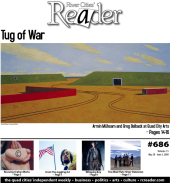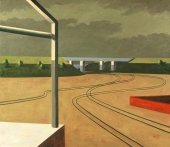 Cold, gray foundations of concrete divide the land. A fiery red dragon with a stair-step body stands in stark opposition to a carefully delineated landscape. All of this is watched by a prickly caterpillar of light. These strange sights can be seen in a disconcerting tug-of-war that pits crisp, eloquent, and restrained paintings against mixed-media sculptures of whimsy, imprecision, and untamed emotion.
Cold, gray foundations of concrete divide the land. A fiery red dragon with a stair-step body stands in stark opposition to a carefully delineated landscape. All of this is watched by a prickly caterpillar of light. These strange sights can be seen in a disconcerting tug-of-war that pits crisp, eloquent, and restrained paintings against mixed-media sculptures of whimsy, imprecision, and untamed emotion.
Liminal Objects & Subliminal Landscapes, at Quad City Arts through June 27, features the mixed-media sculptures of Greg Belback and the paintings of Armin Mühsam. This exhibition creates an unsettling visual tension between Modernist (object-based) aesthetics (predominately Mühsam) and Postmodernist (idea-based) sensibilities (mostly Belback). Mühsam contributes more than 25 "landscape" paintings - primarily oil on canvas - and Belback has nearly a dozen sculptures made from clay, metal, plastics, and lighting elements. The nature of the gallery space, with its long expanses of white walls and large, north-facing windows that flood the space with uncontrolled light, makes it difficult for Belback's illuminated sculptures to hold their own against the paintings.
Mühsam, who was a teaching colleague of mine in fall 2006 at Northwest Missouri State University, works with imagined landscapes based in observation. They feature the interaction and a low-level tension between man-made structures and the land itself, often with buildings, overpasses, and rail lines that cut across the verdant plains like surgical lines incised into flesh. Mühsam capitalizes on the fact that we don't recognize how thoroughly and drastically we have changed the land around us by making works that present this uninhabited reality within the time-honored canon of landscape painting.
When describing his works, Mühsam's purpose and methods are clear: "My paintings ... are executed in the traditional format and medium for landscape painting, deliberately seducing the viewer into appreciating the beauty of utilitarian, technological architecture."
 His pieces can be primarily divided into two stylistically similar groups of work: his broader landscape works, and his physically smaller Foundation series. The landscapes show a wider variety of human influence on the land, while the Foundation pieces showcase maze-like concrete walls cordoning off areas of land and imposing order.
His pieces can be primarily divided into two stylistically similar groups of work: his broader landscape works, and his physically smaller Foundation series. The landscapes show a wider variety of human influence on the land, while the Foundation pieces showcase maze-like concrete walls cordoning off areas of land and imposing order.
The larger landscape works are visually and conceptually more satisfying variations on Mühsam's theme. They utilize juxtapositions of scale (comparing relatively small passages of unaltered land to larger sections of human-influenced land), subtle color oppositions, and stronger, more dynamic compositions to direct the viewer's attention. They have a built-in a-ha moment when you realize that you are looking less at a landscape than at a man-made construction with some green areas.
The Foundation series takes this losing battle between grass and concrete to an extreme. With their dependably centralized concrete structures defiantly tucked into folds in the landscape, they become repetitive in a way that does not expand and explore the idea. The simplicity and straightforwardness of their conflict does not generate the same epiphany as the larger landscape pieces.
In his statement, Mühsam explains: "I have come to the conclusion that technology (read: Western man) writes or draws into a landscape just like an artist would draw on a sheet of paper ... ." Mühsam's work shows this industrialized effort to draw into, and begin to divide and contain, a natural landscape. In several of his works, the natural aspect of the landscape is so thoroughly dominated by human activities that it's nearly a footnote or a garnish.
The oil on canvas Visualized Efficiency is divided into three horizontal bands. The thin center bar of green landscape is broken into two overlapping wedges held together by a dull sky-blue concrete overpass. The swath of land is sandwiched between flowing gray-green clouds above and a warm, earthy passage below. A cool blue and dark-rust man-made structure intrudes from the lower left side, and another structure juts in on the middle right. Nestled between the buildings are three sets of winding train tracks that glide under the overpass. All of the man-made elements lead the viewer's eye to a small patch of blue water behind the overpass. The nearly nonexistent untamed landscape - the small section of water and the narrow swath of land - are outweighed by the tracks, the buildings, and the sickly green (polluted) sky.
Mühsam does not construct his worlds with thick glossy paints and romanticized brush strokes. To emphasize his ideas about restrained nature and oppressive concrete geometries, he paints his man-scapes with sharp, concise lines and soft and blended brush strokes. His cool and clinical approach to rendering the structures spills out into the environment, thereby making the landscape - normally a wild subject matter - as emotionless as the buildings that defile it.
The artist deals in subtleties here. The battle isn't so much between glaringly hot and cold colors as it is lukewarm and cool. The reduced tension of colors echoes our near-total acceptance of this new reality of our environment. His landscapes seem to loosely reference the Ocean Park series of Richard Diebenkorn and the low-to-the-horizon lighting and mysterious undertones of Giorgio di Chirico's work.
The shape and tonal contrasts established by Mühsam have a clear conceptual purpose, juxtaposing man-made elements with nature and illustrating the uneasy relationship between them. On the other hand, Greg Belback's contrasts of materials at times seem under-considered or, at worst, arbitrary. That is not to say that his works aren't a fun visual experience.
 Belback is a sculptor who works with clay, cast aluminum, zip ties, lights, and found objects. Many of his pieces combine materials in surprising and exciting ways that can be somewhat unsettling but also intriguing. His works tend to place more importance on the power of the concept and less on the eloquence of the visual.
Belback is a sculptor who works with clay, cast aluminum, zip ties, lights, and found objects. Many of his pieces combine materials in surprising and exciting ways that can be somewhat unsettling but also intriguing. His works tend to place more importance on the power of the concept and less on the eloquence of the visual.
In his artist statement Belback claims that "clay and cast metal give my work grounding in creating elements from more traditional mediums." This is only partially true, because the presence of the material doesn't impart the "grounding" or the "tradition" nearly as much as the mastery of shaping it. While he uses clay as a component in his sculptures, his handling of the material is far from the refinement of form you would expect to experience in traditional ceramics. The ceramic bases bring a sense of visual confusion and less of a tie to tradition.
Untitled (Line in the Red Dragon) is a roughly 15-foot-long descending red dragon assembled from pipes, threaded rods, lamp bases, a red rope light, and a form that is reminiscent of a Japanese paper lantern made from stacked clear-plastic packaging that has been zip-tied together. The dragon is composed of three pairs of threaded rods, each capped with crown-like cast-aluminum forms. Resting on, or in, the aluminum crowns between each pairing of rods is a section of pipe. Each pairing steps down, and ranges from six feet off of the ground to around two and a half feet high. A long red rope-light has been threaded through the pipes and drapes from section to section, culminating in the fiery form of a lantern at the mouth end and the dragon's tail at the base.
The overwhelming majority of the piece is made from found objects that retain their identities. A pipe stays a pipe and a rope light remains a rope light. The only exceptions to this are the illuminated plastic packaging, which gains a new identity by being transformed into a paper lantern, and the cast-aluminum crowns whose original purpose is not readily identifiable.
The new imagining of a dragon resonates more conceptually because it is an ancient concept given form by modern materials. Although the artist's idea behind the dragon is somewhat ambiguous - during a conversation at the opening reception, Belback told me that the descending red line represents "being in the red" or a trade deficit, and the dragon was Asia as a general concept - it still generates interest.
The artist states that he uses "traditional forms and techniques to produce connections to the nontraditional/contemporary." By physically pairing these materials and techniques (in this case the artist-cast aluminum is the "traditional" material and the pipes, plastic, and rope lights are "nontraditional"), these connections are inescapably made. But any two things paired together make some kind of connection. If the viewer is supposed to perceive the significance of these pairings, it is the artist's responsibility to make those connections meaningful. Because Belback's handling of the materials makes everything seem contemporary, the potential interpretative richness of pairing old and new is often lost.
Similarly, the pairing of Mühsam and Belback prevents either artist's works from resonating to its potential. Belback's illuminated works would benefit greatly from being isolated in a more light-controlled environment, where the internal lighting can really energize the piece. And the controlled and concise nature of Mühsam's paintings constantly fight with the more haphazard appearance of Belback's sculptures.
Liminal Objects & Subliminal Landscapes runs through June 27 at Quad City Arts, and then selected works from this show will be at the Quad City International Airport gallery in July and August.










